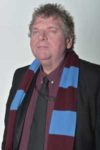
Blind Hammer welcomes West Ham’s continuing fight against discrimination.
West Ham’s leadership in petitioning the Premier League this week to take concerted action against racists fills me with pride.
When I grew up in the 60s and 70s I hated the stereotype of West Ham supporters being ignorant, racist and bigoted.
This caricature was largely fostered by the hilarity which greeted the over the top racists tirades of the fictional West Ham supporting Alf Garnett in the popular TV sitcom Till Death Us Do Part.
I am not blind to the racism that some West Ham supporters let eat into their psyches then and over the following decades or even, sadly, nowadays.
Yet this caricature of East End bigots grossly distorts the real picture.
There is another, more honourable, East End, and West Ham tradition. A finer tradition of which we should rightly feel proud .
It was East Enders who stood shoulder to shoulder with Jewish neighbours to defy the desperate attempts of fascists to engender anti-Semitic hatred in the 1930s.
The Battle of Cable Street helped ensure that Britain never spiralled into the dark horror of divided communities as in Nazi Germany.
The East End has always been an area of diversity in culture and backgrounds. It should not be that surprising then There is also a West Ham tradition of drawing upon that community.
This tradition is actually embedded in the very roots of our club. Whilst West Ham were still playing at the Memorial Ground in the 19th Century they fielded a black player from the East End.
This Victorian West Ham line up included Fred Corbett, a product of the close relationship West Ham had with the phenomenally successful local St Luke’ Team. I will have a lot more to say about Fred Corbett in an upcoming blog.
More famous is the ground breaking opportunities Ron Greenwood provided for black players in the West Ham teams of the 60s and 70s.
The first ever West Ham team I watched in 1968 had a black player in the side. John Charles was a skilful and solid left back. I can still remember him starting the move which ended up with Martin Peters scoring the Big Match TV Goal of the Season.
By 1970 His son Clive ,, also signed as a professional with West Ham, albeit with what turned out to be more bumpy personal circumstances in his career.
Still by 1971 West Ham had three black players on their professional books. As well as Clyde Best and Clive Charles they had Ade Coker.
I remember the stunning goal Ade Coker scored against Crystal Palace, on his debut, in West Ham demolition of Palace at Selhurst Park.
Another black player, Clyde Best joined Coker on the scoresheet that day. I suspect it was the first time ever that two black players had scored in the same game at the highest level.
The following should be a YouTube link to the Crystal Palace game.
https://www.youtube.com/watch?v=Om6FqYB_W0w
I remember the joy with which thousands of us Hammers standing at Palace that day greeted Coker’s stunning goal. We thought we had the new Pele.
Sadly Coker’s impact was short lived but the important fact was that he was given the opportunity.
If you read the biographies of Clyde Best and Leroy Rosenior you will find black players with a defensive love of our club and appreciation of the support they enjoyed. Best insists on this despite the experience of receiving a bizarre hate letter threatening him with an acid attack.
Best points out that it was Ron Greenwood and not Ron Atkinson who broke the mould and introduced black players to the top level of the English game, nearly years before the West Brom “3 degrees:”. of Regis Cunnigham and Batson.
In In his introduction to Clyde Best’s autobiography Cyril Regis explained it was Clyde Best’s example WHICH INSPIRED HIM TO BELIEVE HE too, COULD grow up to MAKE IT as a black professional footballer .
Leroy Rosenior has plenty to say about the racism he endured at other clubs but has not a word of complaint about West Ham. Instead he celebrated the adulation he received at Upton Park.
These recollections are in stark contrast to the horrific accounts Paul Cannoville makes in his auto biography “Black and Blue”. Here the abuse he received from fans at Chelsea shook him to the core.
The torrent of hatred he encountered affected his mental health to the extent he dreaded approaching Stamford Bridge. Most upsetting is the account of his debut when so called Chelsea fans chanted just yards away from him, “we don’t want no f****** n*******.
Finally as someone who has had the experience of working with West Ham behind the scenes to try and help improve access for disabled supporters I can assure you all that the ethos and commitment at the club is one of genuine commitment to fight discrimination in all its forms.
So West Ham may still have some racist supporters but they, in reality do not represent the best traditions of our club and have no real home here.
We have a finer more honourable tradition and we should celebrate it more.
David Griffith




Wow David,
I thoroughly enjoyed reading this post.
Kudos to you.